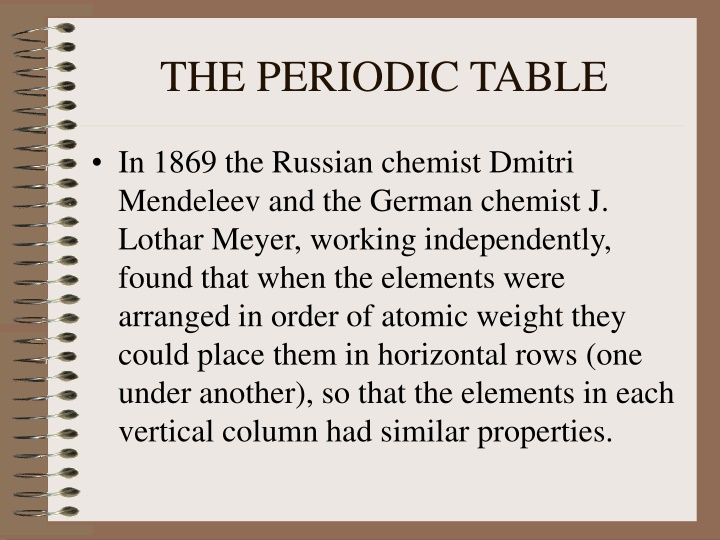
Fascinating Insight into the Periodic Table Evolution
Discover the evolution of the Periodic Table pioneered by Mendeleev and Meyer, the modern arrangement based on atomic numbers, and the distinction among metals, nonmetals, and metalloids. Explore the unique characteristics of elements showcased in a comprehensive PowerPoint resource provided by World of Teaching.
Download Presentation

Please find below an Image/Link to download the presentation.
The content on the website is provided AS IS for your information and personal use only. It may not be sold, licensed, or shared on other websites without obtaining consent from the author. If you encounter any issues during the download, it is possible that the publisher has removed the file from their server.
You are allowed to download the files provided on this website for personal or commercial use, subject to the condition that they are used lawfully. All files are the property of their respective owners.
The content on the website is provided AS IS for your information and personal use only. It may not be sold, licensed, or shared on other websites without obtaining consent from the author.
E N D
Presentation Transcript
THE PERIODIC TABLE In 1869 the Russian chemist Dmitri Mendeleev and the German chemist J. Lothar Meyer, working independently, found that when the elements were arranged in order of atomic weight they could place them in horizontal rows (one under another), so that the elements in each vertical column had similar properties.
THE PERIODIC TABLE This tabular arrangement of the elements in rows and columns, highlighting the regular repetition of properties of the elements is called a periodic table.
THE PERIODIC TABLE It was shown in the early part of last century (1900s) that the elements are characterized by their atomic numbers, rather than their atomic weights. The modern periodic table lists the atomic number, atomic symbol, and atomic weight of each element.
THE PERIODIC TABLE METALS NONMETALS METALLOIDS A substance or mixture that has a characteristic luster or shine, is generally a good conductor of heat & electricity, & is malleable & ductile. Except for mercury, the metallic elements are solids at room temperature (~20 C) An element that does not exhibit the characteristics of a metal; they are generally solids or gases and are usually hard, brittle substances. An element having both metallic and nonmetallic properties. They are usually good semiconductors Bromine is the only liquid nonmetal.
This powerpoint was kindly donated to www.worldofteaching.com http://www.worldofteaching.com is home to over a thousand powerpoints submitted by teachers. This is a completely free site and requires no registration. Please visit and I hope it will help in your teaching.
